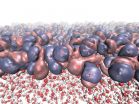(Press-News.org) New apps developed for children come online every day and many of them are marketed or labeled as "educational" - but how can we tell which of these thousands of apps will actually help children learn? A comprehensive new report published in Psychological Science in the Public Interest, a journal of the Association for Psychological Science, integrates research from scientific disciplines like psychological science, linguistics, and neuroscience to provide an evidence-based guide that parents, educators, and app designers alike can use to evaluate the quality of so-called "educational" apps.
Since the iPad was introduced just five years ago, over 80,000 educational apps have become available in the Apple app store, which means apps are being developed far faster than the scientific community can evaluate them, say report authors Kathy Hirsh-Pasek (Temple University), Jennifer Zosh (Penn State University, Brandywine), Roberta Michnick Golinkoff (University of Delaware), James H. Gray (Sesame Workshop), Michael B. Robb (Fred Rogers Center at Saint Vincent College), and Jordy Kaufman (Swinburne University of Technology).
The full report and accompanying commentary by communications researcher Ellen Wartella (Northwestern University) are available free to the public online.
While scientific research examining specific features of individual apps may be scarce, scientists have amassed a wealth of knowledge about how children learn and this knowledge is directly applicable to the assessment of new forms of digital media, including apps, the authors say.
In their report, Hirsh-Pasek, Zosh, Golinkoff and colleagues present a comprehensive review of research from many disciplines related to the science of learning, offering a set of four evidence-based principles that can be used as guide, both by developers creating new products and by parents hoping to find high quality games for their children.
The researchers conclude that "educational" apps best support learning when they are:
Active in a way that requires mental effort and not just swiping
Engaging, not distracting
Meaningful in the context of a child's life
Socially interactive because children learn best with others including parents and peers
"These four principles can help us distinguish apps that masquerade as educational from those most likely to engage children in an educationally meaningful experience," the researchers say. While not all of these principles are necessary, the more an app promotes these types of learning experiences, the greater the educational value of the app will likely be.
The researchers point out that many apps feature content that seems educational, like letters or numbers, but this doesn't mean that they have true educational value. For example, studies have shown that e-storybooks that contain lots of "bells and whistles" can distract young children from attending to and learning from the actual story. These findings suggest that apps that feature attention-grabbing sound, movement, or other visual elements may be more distracting than they are engaging, and are unlikely to serve as effective educational tools.
"There are a number of great apps in the marketplace," the researchers note. "One of the major reasons we sought to complete this project was to empower a much wider audience to be educated consumers and developers of apps. Since we embarked on this project, we have been approached by a number of the leading app developers who seem excited to include more of the scientifically informed processes in their product lines."
With the science of learning at their core, Hirsh-Pasek, Zosh, Golinkoff, and colleagues believe that the next generation of apps will be able to fully realize their potential as effective and engaging educational tools.
INFORMATION:
For more information about this study, please contact:
Kathy Hirsh-Pasek at khirshpa@temple.edu.
Jennifer Zosh at jzosh@psu.edu.
Psychological Science in the Public Interest (Volume 16, Number 1)
Putting Education in 'Educational' Apps: Lessons From the Science of Learning
http://psi.sagepub.com/cgi/content/full/16/1/3?ijkey=GxHiSvddIDi.E&keytype=ref&siteid=sppsi
Educational Apps: What We Do and Do Not Know
http://psi.sagepub.com/cgi/content/full/16/1/1?ijkey=.iIo2GcGXzknM&keytype=ref&siteid=sppsi
Psychological Science in the Public Interest is a journal of the Association for Psychological Science. It publishes an eclectic mix of thought-provoking articles on the latest important advances in psychology. For a copy of the article "Putting Education in 'Educational' Apps: Lessons From the Science of Learning" and access to other Psychological Science in the Public Interest research findings, please contact Anna Mikulak at 202-293-9300 or amikulak@psychologicalscience.org.
HANOVER, N.H. - Although the media often portray the Arctic as a new "Great Game" ripe for conflict, a group of international Arctic experts co-chaired by Dartmouth College released recommendations today aimed at preserving the polar north as an area for political and military cooperation, sustainable development and scientific research.
The report, which addresses the priorities of the Arctic Council, an intergovernmental forum of the eight nations that border the polar region, resulted from meetings at the Carnegie Endowment for International Peace in Washington, ...
Only three wolves seem to remain in Isle Royale National Park. Researchers from Michigan Technological University observed the wolves during their annual Winter Study, and the lone group, at an unprecedented low, is a sharp decline from nine wolves observed last winter.
The study's report, released today, marks the project's 57th year of observing wolves and moose in Isle Royale. It is the longest running predator-prey study in the world. This year, along with the three resident wolves, scientists estimated 1,250 moose on the island and observed two visiting wolves, ...
Massachusetts General Hospital (MGH) investigators have found the probable mechanism underlying a previously described biomarker associated with the risk of developing serious diseases ranging from cancer to cardiovascular disease and the risk of serious complications. In a paper published in the American Journal of Hematology, the research team reports finding that higher levels of a measure routinely taken as part of the complete blood count - the extent of variation in the size of red blood cells - is caused by reduced clearance of aging cells from the bloodstream. Hundreds ...
When you take a medication for, say, high cholesterol, do you know that pill is really what the label says it is? Depending upon the type of medicine and where you live, the threat of falsified medications (also referred to as counterfeit, fraudulent, and substandard) can be quite real, yet the full scope and prevalence of the problem is poorly understood, say researchers at University of California, San Diego School of Medicine in a new report published April 20 in the American Journal of Tropical Medicine and Hygiene.
Counterfeit medicines have traditionally been defined ...
DURHAM, N.C. -- While the female baboon's big red bottom may be an eyesore to some, it has an aphrodisiac effect on her mates. Biologists have long thought that baboon males prefer females with bigger backsides as the mark of a good mother, but new research suggests it isn't so simple.
A study of wild baboons in southern Kenya reveals that the size of a female's swollen rump doesn't matter as much as previously thought.
The study appears online in the journal Animal Behaviour.
Baboons breed throughout the year, and mating occurs during times when a female's behind ...
ALEXANDRIA, VA, APRIL 20, 2015 - Higher-than-expected rates of pediatric cancers have been identified in the Miami metro area and an area west of the Everglades in a series of five statistical analyses conducted for Science and Public Policy, an open-access, online public-policy journal published by the American Statistical Association (ASA).
In a review of the analyses for Science and Public Policy, Lance A. Waller, a biostatistics professor specializing in spatial epidemiology at Emory University in Atlanta, urges care in next steps, recommending that state and local ...
WASHINGTON, April 20, 2015 -- Wednesday, April 22 large-scale use of chemical weapons in warfare. Some of the best minds in chemistry at that time, including a Nobel Prize winner, used their knowledge of science to build humanity's new weapons of mass destruction. Reactions presents this sobering look at the chemistry behind the modern world's first chemical weapons. Check out the video here: http://youtu.be/e8W3dOURya0.
Check out all of C&EN's great coverage of the 100th anniversary of chemical weapons at http://chemicalweapons.cenmag.org.
INFORMATION:Subscribe to ...
PITTSBURGH--As people find ever more inventive uses for smartphones, touchscreens sometimes fall short as control surfaces. Researchers at Carnegie Mellon University and Disney Research have developed an inexpensive alternative - a toolbox of physical knobs, sliders and other mechanisms that can be readily added to any device.
The researchers drew inspiration from wind instruments in devising these mechanisms, which they call Acoustruments. The idea is to use pluggable plastic tubes and other structures to connect the smartphone's speaker with its microphone. The device ...
ATLANTA -April 20, 2015- Despite strong evidence and guidelines supporting its use, post-surgical radiation therapy for prostate cancer patients at risk of recurrence is declining in the United States. The study, published online in the journal European Urology, finds fewer than 10 percent of patients at risk of recurrence received postoperative radiotherapy within six months of surgery in the U.S.
Although radical prostatectomy (RP) is a common curative treatment for localized prostate cancer, about 30% of patients will develop biochemical recurrence after surgery, ...
The National Physical Laboratory (NPL), the UK's National Measurement Institute in collaboration with IBM and the University of Edinburgh, has used a new quantum model to reveal the molecular structure of water's liquid surface.
The liquid-vapour interface of water is one of the most common of all heterogeneous (or non-uniform) environments. Understanding its molecular structure will provide insight into complex biochemical interactions underpinning many biological processes. But experimental measurements of the molecular structure of water's surface are challenging, ...




